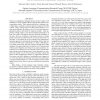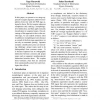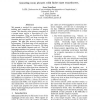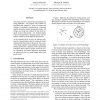ICASSP
2011
IEEE
13 years 6 months ago
2011
IEEE
Korean is an agglutinative language that does not have explicit word boundaries. It is also a highly inflective language that exhibits severe coarticulation effects. These charac...
COLING
2010
13 years 10 months ago
2010
In this paper, we present a two-stage approach to acquire Japanese unknown morphemes from text with full POS tags assigned to them. We first acquire unknown morphemes only making ...
ACTAC
2006
14 years 3 months ago
2006
In this paper we introduce a statistical Named Entity recognizer (NER) system for the Hungarian language. We examined three methods for identifying and disambiguating proper nouns...
ACL
1998
14 years 4 months ago
1998
We present a method for constructing, maintaining and consulting a database of proper nouns. We describe noun phrases composed of a proper noun and/or a description of a human occ...
ACL
2003
14 years 4 months ago
2003
This paper describes a classifier that assigns semantic thesaurus categories to unknown Chinese words (words not already in the CiLin thesaurus and the Chinese Electronic Dictiona...
LREC
2008
14 years 4 months ago
2008
We present the results of an agreement task carried out in the framework of the KNOW Project and consisting in manually annotating an agreement sample totaling 50 sentences extrac...
EMNLP
2007
14 years 4 months ago
2007
We present a method for learning to find English to Chinese transliterations on the Web. In our approach, proper nouns are expanded into new queries aimed at maximizing the probab...
NLPRS
2001
Springer
14 years 7 months ago
2001
Springer
Translating news articles frequently involves finding foreign language equivalents for proper nouns occurring for the first time in an original article, a time-consuming and labor...
CLEANDB
2006
ACM
14 years 9 months ago
2006
ACM
The paper presents a data cleansing technique for string databases. We propose and evaluate an algorithm that identifies a group of strings that consists of (multiple) occurrence...




